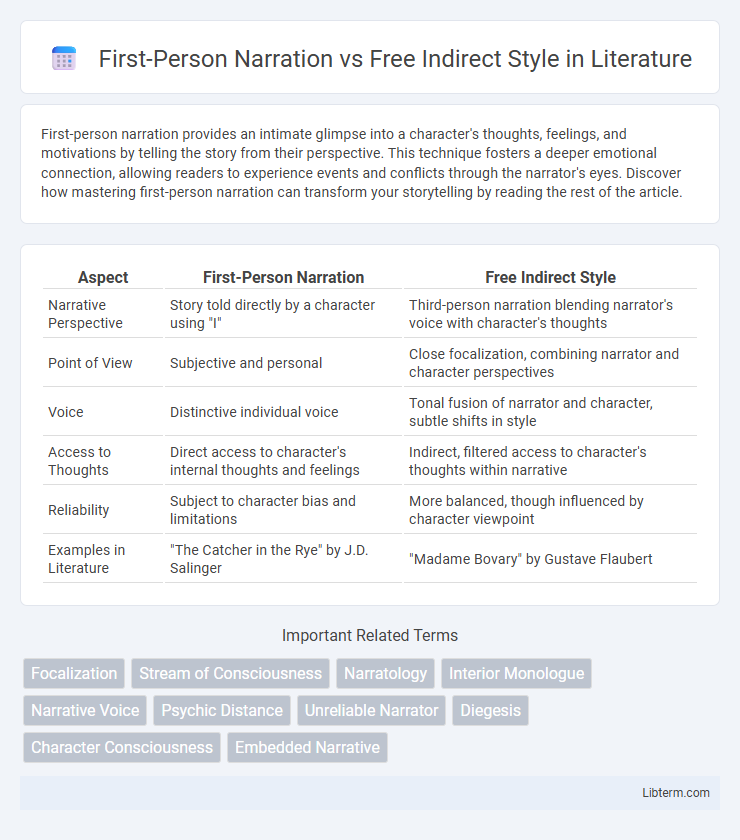First-person narration provides an intimate glimpse into a character's thoughts, feelings, and motivations by telling the story from their perspective. This technique fosters a deeper emotional connection, allowing readers to experience events and conflicts through the narrator's eyes. Discover how mastering first-person narration can transform your storytelling by reading the rest of the article.
Table of Comparison
| Aspect | First-Person Narration | Free Indirect Style |
|---|---|---|
| Narrative Perspective | Story told directly by a character using "I" | Third-person narration blending narrator's voice with character's thoughts |
| Point of View | Subjective and personal | Close focalization, combining narrator and character perspectives |
| Voice | Distinctive individual voice | Tonal fusion of narrator and character, subtle shifts in style |
| Access to Thoughts | Direct access to character's internal thoughts and feelings | Indirect, filtered access to character's thoughts within narrative |
| Reliability | Subject to character bias and limitations | More balanced, though influenced by character viewpoint |
| Examples in Literature | "The Catcher in the Rye" by J.D. Salinger | "Madame Bovary" by Gustave Flaubert |
Introduction to Narrative Techniques
First-person narration offers a direct and immersive perspective by allowing readers to experience the story through the protagonist's eyes, emphasizing personal thoughts and emotions. Free indirect style blends third-person narration with the character's internal voice, providing insight into a character's mindset without explicit first-person commentary. Both techniques shape narrative intimacy and influence readers' connection to characters and plot development.
Defining First-Person Narration
First-person narration centers the storytelling perspective within a character using pronouns like "I" and "we," providing direct access to their thoughts, emotions, and personal experiences. This narrative style creates intimacy and immediacy, as the audience perceives events through the narrator's subjective viewpoint. Unlike free indirect style, which blends the narrator's voice with a character's consciousness, first-person narration maintains a clear, singular narrative voice rooted in one character's identity.
Understanding Free Indirect Style
Free indirect style blends third-person narration with the character's thoughts and feelings, creating a seamless shift between the narrator's voice and the character's inner perspective without direct quotations. This narrative technique allows readers to access a character's subjective experience while maintaining an external point of view, enhancing emotional depth and psychological insight. Commonly used in modernist literature, free indirect style enables subtle expression of consciousness, making it distinct from the explicit, personal tone of first-person narration.
Key Differences Between the Two Styles
First-person narration provides a direct account from the protagonist's perspective, using "I" to convey personal thoughts and emotions intimately. Free indirect style blurs the boundaries between the narrator's voice and the character's inner thoughts, offering a third-person narrative that seamlessly integrates subjective impressions without explicit first-person articulation. The key difference lies in the level of narrator involvement and perspective clarity, with first-person narration emphasizing personal subjectivity and free indirect style balancing external narration with internal experience.
Psychological Depth and Character Insight
First-person narration provides direct access to a character's inner thoughts and emotions, offering an intimate psychological depth through their personal perspective. Free indirect style blends the narrator's voice with the character's consciousness, creating nuanced character insight by subtly revealing thoughts without explicit first-person disclosure. This hybrid technique allows readers to perceive complex emotions and motivations while maintaining narrative distance, enhancing psychological realism.
Reader Engagement and Immersion
First-person narration immerses readers directly into the protagonist's thoughts and emotions, creating strong personal connections and a subjective viewpoint that fosters deep reader engagement. Free indirect style blends third-person narration with the character's inner voice, offering subtle shifts between external description and internal insight, which maintains immersive intimacy while allowing broader narrative perspective. This technique enhances reader involvement by seamlessly merging narrative distance with emotional immediacy, appealing to those who prefer nuanced character experiences.
Flexibility in Storytelling
First-person narration offers a singular, immersive perspective that deeply connects readers to a character's inner thoughts and emotions, creating intimacy but limiting the scope to one viewpoint. Free indirect style blends third-person narration with the character's voice, allowing seamless shifts between narrative and internal monologue while maintaining narrative fluidity. This technique grants storytellers greater flexibility to explore multiple characters' consciousnesses without breaking narrative continuity, enhancing depth and complexity.
Examples in Classic and Contemporary Literature
First-person narration offers intimate insight through characters' direct voice, as seen in classic works like "The Catcher in the Rye" by J.D. Salinger, where Holden Caulfield's perspective shapes the entire narrative. Free indirect style blends third-person narration with a character's internal thoughts, exemplified in Jane Austen's "Emma," enabling seamless shifts between narrator and character consciousness. Contemporary literature such as Zadie Smith's "Swing Time" employs free indirect style to subtly convey protagonists' emotions while maintaining narrative distance.
Effects on Voice and Tone
First-person narration creates an intimate voice by presenting the story directly through the protagonist's perspective, allowing readers to access their internal thoughts and emotions in a distinct, personal tone. Free indirect style blends the narrator's voice with the character's consciousness, subtly merging external narration and internal monologue, which produces a more nuanced and fluid tone that can shift between objective and subjective viewpoints. This narrative technique enhances the complexity of voice by providing insight into characters' minds without the explicit boundary of first-person subjectivity.
Choosing the Best Narrative Mode
First-person narration offers a deep, intimate perspective by filtering the story through a single character's thoughts and experiences, creating strong emotional connections with readers. Free indirect style blends third-person narration with the character's voice and thoughts without explicit attribution, allowing subtle shifts in perspective and maintaining narrative distance. Choosing the best narrative mode depends on the desired balance between immediacy and narrative flexibility, as first-person intensifies personal engagement while free indirect style provides nuanced insight without losing authorial control.
First-Person Narration Infographic

 libterm.com
libterm.com